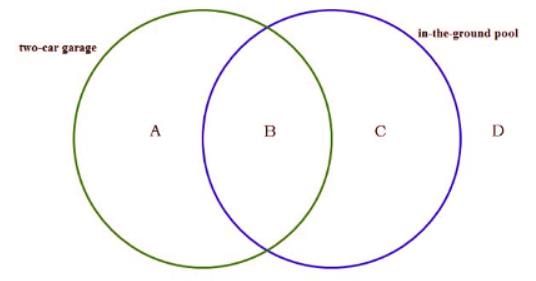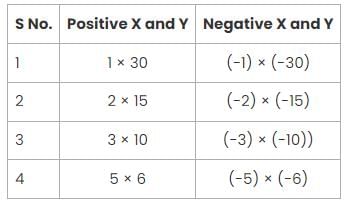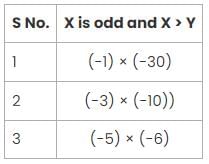Executive Assessment Mock Test - 9 - GMAT MCQ
30 Questions MCQ Test - Executive Assessment Mock Test - 9

The government of Storinia has proposed to conduct several particle physics experiments in Antarctica, as described below.
The ultra-high-energy cosmic ray detector (UHECR-D) will track a variety of subatomic particles traveling from outer space with exceptionally high kinetic energy by recording secondary showers of particles created by these UHECRs as they collide with the upper atmosphere.
The polyethylene naphthalate neutrino observatory (PEN-NO) will search for neutrinos, extremely light and fast subatomic particles that interact only weakly with normal matter. To prevent spurious results from cosmic rays, PEN-NO will be buried deep below the ice.
The magnetic monopole detector (MaMoD) will attempt to verify the existence of magnetic monopoles, hypothetical subatomic particles postulated by some physical theories to be left over from the creation of the universe.

The purpose of UHECR-D is to ascertain the identity, composition, and extraterrestrial origin of ultra-high-energy cosmic rays, which are much less prevalent and well-understood than lower-energy cosmic rays. PEN-NO will measure the mass and speed of neutrinos produced in particle accelerators and nuclear reactors, both to reduce uncertainty in the known mass of a neutrino and to contribute to the resolution of a recent challenge to Einstein's theory of relativity posed by the observation of neutrinos supposedly traveling slightly faster than light. PEN-NO will also measure the passage of solar and other neutrinos of astronomical origin. Finally, if MaMoD is successful in its search, it will provide experimental proof for Dirac's explanation of charge quantization and fix an asymmetry in Maxwell's equations of electromagnetism.

The government of Storinia projects that it will cost $42 million in total and take 2 years to construct UHECR-D, PEN-NO, and MaMoD. The government also projects that once construction is finished, the annual operating budget for each experiment will be $3.6 million for UHECR-D, $4.3 million for PEN-NO, and $2.7 million for MaMoD. All these figures are in real 2012 dollars (removing the effect of predicted inflation).
Q. For each of the following statements, select Yes if the statement is supported by the evidence provided. Otherwise, select No.
1. With a construction budget of $30 million, the Storinian government will be able to search for a proof of an explanation of charge quantization and to help resolve a controversy by measuring the speed of neutrinos produced in nuclear reactors.
2. In its Antarctic experiments, the Storinian government will attempt to ascertain the mass and speed of cosmic rays and to confirm the composition of magnetic monopoles.
3. If the PEN-NO experiment is kept in operation on the surface of the ice in Antarctica, its findings will be considered more valid than those produced by the experiment as currently envisioned.

The ultra-high-energy cosmic ray detector (UHECR-D) will track a variety of subatomic particles traveling from outer space with exceptionally high kinetic energy by recording secondary showers of particles created by these UHECRs as they collide with the upper atmosphere.
The polyethylene naphthalate neutrino observatory (PEN-NO) will search for neutrinos, extremely light and fast subatomic particles that interact only weakly with normal matter. To prevent spurious results from cosmic rays, PEN-NO will be buried deep below the ice.
The magnetic monopole detector (MaMoD) will attempt to verify the existence of magnetic monopoles, hypothetical subatomic particles postulated by some physical theories to be left over from the creation of the universe.



The government of Storinia has proposed to conduct several particle physics experiments in Antarctica, as described below.
The ultra-high-energy cosmic ray detector (UHECR-D) will track a variety of subatomic particles traveling from outer space with exceptionally high kinetic energy by recording secondary showers of particles created by these UHECRs as they collide with the upper atmosphere.
The polyethylene naphthalate neutrino observatory (PEN-NO) will search for neutrinos, extremely light and fast subatomic particles that interact only weakly with normal matter. To prevent spurious results from cosmic rays, PEN-NO will be buried deep below the ice.
The magnetic monopole detector (MaMoD) will attempt to verify the existence of magnetic monopoles, hypothetical subatomic particles postulated by some physical theories to be left over from the creation of the universe.

The purpose of UHECR-D is to ascertain the identity, composition, and extraterrestrial origin of ultra-high-energy cosmic rays, which are much less prevalent and well-understood than lower-energy cosmic rays. PEN-NO will measure the mass and speed of neutrinos produced in particle accelerators and nuclear reactors, both to reduce uncertainty in the known mass of a neutrino and to contribute to the resolution of a recent challenge to Einstein's theory of relativity posed by the observation of neutrinos supposedly traveling slightly faster than light. PEN-NO will also measure the passage of solar and other neutrinos of astronomical origin. Finally, if MaMoD is successful in its search, it will provide experimental proof for Dirac's explanation of charge quantization and fix an asymmetry in Maxwell's equations of electromagnetism.

The government of Storinia projects that it will cost $42 million in total and take 2 years to construct UHECR-D, PEN-NO, and MaMoD. The government also projects that once construction is finished, the annual operating budget for each experiment will be $3.6 million for UHECR-D, $4.3 million for PEN-NO, and $2.7 million for MaMoD. All these figures are in real 2012 dollars (removing the effect of predicted inflation).
According to the information provided, the proposed measurement of which of the following kinds of particles is intended to improve the quality of estimation of the mass of these particles?

The ultra-high-energy cosmic ray detector (UHECR-D) will track a variety of subatomic particles traveling from outer space with exceptionally high kinetic energy by recording secondary showers of particles created by these UHECRs as they collide with the upper atmosphere.
The polyethylene naphthalate neutrino observatory (PEN-NO) will search for neutrinos, extremely light and fast subatomic particles that interact only weakly with normal matter. To prevent spurious results from cosmic rays, PEN-NO will be buried deep below the ice.
The magnetic monopole detector (MaMoD) will attempt to verify the existence of magnetic monopoles, hypothetical subatomic particles postulated by some physical theories to be left over from the creation of the universe.



The government of Storinia has proposed to conduct several particle physics experiments in Antarctica, as described below.
The ultra-high-energy cosmic ray detector (UHECR-D) will track a variety of subatomic particles traveling from outer space with exceptionally high kinetic energy by recording secondary showers of particles created by these UHECRs as they collide with the upper atmosphere.
The polyethylene naphthalate neutrino observatory (PEN-NO) will search for neutrinos, extremely light and fast subatomic particles that interact only weakly with normal matter. To prevent spurious results from cosmic rays, PEN-NO will be buried deep below the ice.
The magnetic monopole detector (MaMoD) will attempt to verify the existence of magnetic monopoles, hypothetical subatomic particles postulated by some physical theories to be left over from the creation of the universe.

The purpose of UHECR-D is to ascertain the identity, composition, and extraterrestrial origin of ultra-high-energy cosmic rays, which are much less prevalent and well-understood than lower-energy cosmic rays. PEN-NO will measure the mass and speed of neutrinos produced in particle accelerators and nuclear reactors, both to reduce uncertainty in the known mass of a neutrino and to contribute to the resolution of a recent challenge to Einstein's theory of relativity posed by the observation of neutrinos supposedly traveling slightly faster than light. PEN-NO will also measure the passage of solar and other neutrinos of astronomical origin. Finally, if MaMoD is successful in its search, it will provide experimental proof for Dirac's explanation of charge quantization and fix an asymmetry in Maxwell's equations of electromagnetism.

The government of Storinia projects that it will cost $42 million in total and take 2 years to construct UHECR-D, PEN-NO, and MaMoD. The government also projects that once construction is finished, the annual operating budget for each experiment will be $3.6 million for UHECR-D, $4.3 million for PEN-NO, and $2.7 million for MaMoD. All these figures are in real 2012 dollars (removing the effect of predicted inflation).
Q. For each of the following particle types, select Can Conclude if you can conclude from the information provided that the particles in question have a minimal effect on ordinary matter. Otherwise, select Cannot Conclude.
1. Ultra-high-energy cosmic ray
2. Neutrinos produced in particle accelerators
3. Magnetic monopole

The ultra-high-energy cosmic ray detector (UHECR-D) will track a variety of subatomic particles traveling from outer space with exceptionally high kinetic energy by recording secondary showers of particles created by these UHECRs as they collide with the upper atmosphere.
The polyethylene naphthalate neutrino observatory (PEN-NO) will search for neutrinos, extremely light and fast subatomic particles that interact only weakly with normal matter. To prevent spurious results from cosmic rays, PEN-NO will be buried deep below the ice.
The magnetic monopole detector (MaMoD) will attempt to verify the existence of magnetic monopoles, hypothetical subatomic particles postulated by some physical theories to be left over from the creation of the universe.



Email from Marketing Director to Marketing Researcher on October 4, 2011.
As you know, our revenue growth rate has declined for the past three quarters. To address this, I suggest that we initiate a massive advertising buy. On three separate occasions, in 1978, 1987, and 1993, we have responded to falling revenues by increasing our advertising expenditures by 30%. On all three occasions, within one quarter, our revenues began to increase again. Therefore, if we increase the number of advertisements targeted at our top consumers by 30%, we will once again increase our revenues.
Since our top consumers are females aged 15 − 25, compile a list of the top two television programs watched by that group. Also research the prices for a 30-second commercial for each television program.

Email from Marketing Researcher to Marketing Director on October 10, 2011.
We’ve hit a slight complication in our research. While we’ve had no problem determining the top two programs and advertising prices for each, we’ve realized that there is a fair amount of overlap between the viewers of the two programs. We’ve found that 80% of the audience for Hart Attack also watches Blonde Fury.
I’ll send you the chart summarizing the audience size and advertising prices tomorrow.

MEMORANDUM
TO: Marketing Director
FROM: Marketing Researcher
DATE:
October 11, 2011
RE: Market Research Results
The attached chart presents the results from our research on the top 2 television programs for Females aged 15-25.
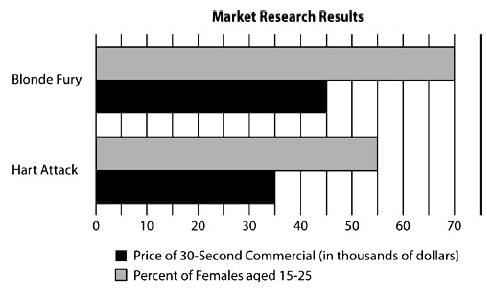
Q. Consider each of the following statements. Does the information in the memo and the table support the inference as stated?
More females aged 15-25 watch Blonde Fury than do any other group.

Email from Marketing Director to Marketing Researcher on October 4, 2011.
As you know, our revenue growth rate has declined for the past three quarters. To address this, I suggest that we initiate a massive advertising buy. On three separate occasions, in 1978, 1987, and 1993, we have responded to falling revenues by increasing our advertising expenditures by 30%. On all three occasions, within one quarter, our revenues began to increase again. Therefore, if we increase the number of advertisements targeted at our top consumers by 30%, we will once again increase our revenues.
Since our top consumers are females aged 15 − 25, compile a list of the top two television programs watched by that group. Also research the prices for a 30-second commercial for each television program.

Email from Marketing Researcher to Marketing Director on October 10, 2011.
We’ve hit a slight complication in our research. While we’ve had no problem determining the top two programs and advertising prices for each, we’ve realized that there is a fair amount of overlap between the viewers of the two programs. We’ve found that 80% of the audience for Hart Attack also watches Blonde Fury.
I’ll send you the chart summarizing the audience size and advertising prices tomorrow.

MEMORANDUM
TO: Marketing Director
FROM: Marketing Researcher
DATE:
October 11, 2011
RE: Market Research Results
The attached chart presents the results from our research on the top 2 television programs for Females aged 15-25.
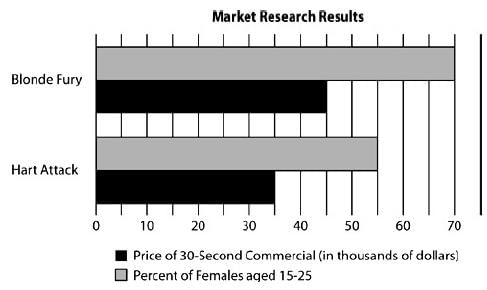
Q. Consider each of the following statements. Does the information in the memo and the table support the inference as stated?
Advertisements are more expensive during higher rated programs.

Email from Marketing Director to Marketing Researcher on October 4, 2011.
As you know, our revenue growth rate has declined for the past three quarters. To address this, I suggest that we initiate a massive advertising buy. On three separate occasions, in 1978, 1987, and 1993, we have responded to falling revenues by increasing our advertising expenditures by 30%. On all three occasions, within one quarter, our revenues began to increase again. Therefore, if we increase the number of advertisements targeted at our top consumers by 30%, we will once again increase our revenues.
Since our top consumers are females aged 15 − 25, compile a list of the top two television programs watched by that group. Also research the prices for a 30-second commercial for each television program.

Email from Marketing Researcher to Marketing Director on October 10, 2011.
We’ve hit a slight complication in our research. While we’ve had no problem determining the top two programs and advertising prices for each, we’ve realized that there is a fair amount of overlap between the viewers of the two programs. We’ve found that 80% of the audience for Hart Attack also watches Blonde Fury.
I’ll send you the chart summarizing the audience size and advertising prices tomorrow.

MEMORANDUM
TO: Marketing Director
FROM: Marketing Researcher
DATE:
October 11, 2011
RE: Market Research Results
The attached chart presents the results from our research on the top 2 television programs for Females aged 15-25.
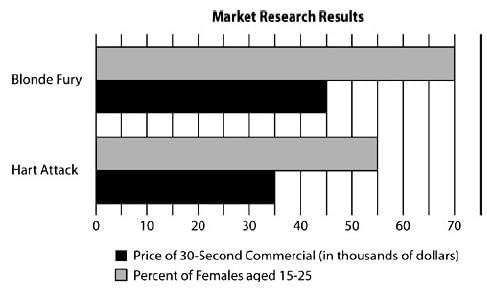
Q. Consider each of the following statements. Does the information in the memo and the table support the inference as stated?
Hart Attack has a higher ratio of viewers per dollar spent on advertising than Blonde Fury.

Email from Marketing Director to Marketing Researcher on October 4, 2011.
As you know, our revenue growth rate has declined for the past three quarters. To address this, I suggest that we initiate a massive advertising buy. On three separate occasions, in 1978, 1987, and 1993, we have responded to falling revenues by increasing our advertising expenditures by 30%. On all three occasions, within one quarter, our revenues began to increase again. Therefore, if we increase the number of advertisements targeted at our top consumers by 30%, we will once again increase our revenues.
Since our top consumers are females aged 15 − 25, compile a list of the top two television programs watched by that group. Also research the prices for a 30-second commercial for each television program.

Email from Marketing Researcher to Marketing Director on October 10, 2011.
We’ve hit a slight complication in our research. While we’ve had no problem determining the top two programs and advertising prices for each, we’ve realized that there is a fair amount of overlap between the viewers of the two programs. We’ve found that 80% of the audience for Hart Attack also watches Blonde Fury.
I’ll send you the chart summarizing the audience size and advertising prices tomorrow.

MEMORANDUM
TO: Marketing Director
FROM: Marketing Researcher
DATE:
October 11, 2011
RE: Market Research Results
The attached chart presents the results from our research on the top 2 television programs for Females aged 15-25.
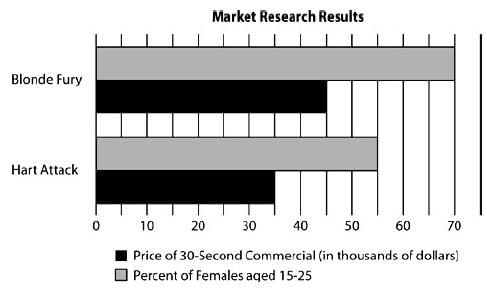
Q. Consider each of the following statements. Does the information in the memo and the table support the inference as stated?
Females aged 15-25 make up the majority of the company’s customers.

Email from Marketing Director to Marketing Researcher on October 4, 2011.
As you know, our revenue growth rate has declined for the past three quarters. To address this, I suggest that we initiate a massive advertising buy. On three separate occasions, in 1978, 1987, and 1993, we have responded to falling revenues by increasing our advertising expenditures by 30%. On all three occasions, within one quarter, our revenues began to increase again. Therefore, if we increase the number of advertisements targeted at our top consumers by 30%, we will once again increase our revenues.
Since our top consumers are females aged 15 − 25, compile a list of the top two television programs watched by that group. Also research the prices for a 30-second commercial for each television program.

Email from Marketing Researcher to Marketing Director on October 10, 2011.
We’ve hit a slight complication in our research. While we’ve had no problem determining the top two programs and advertising prices for each, we’ve realized that there is a fair amount of overlap between the viewers of the two programs. We’ve found that 80% of the audience for Hart Attack also watches Blonde Fury.
I’ll send you the chart summarizing the audience size and advertising prices tomorrow.

MEMORANDUM
TO: Marketing Director
FROM: Marketing Researcher
DATE:
October 11, 2011
RE: Market Research Results
The attached chart presents the results from our research on the top 2 television programs for Females aged 15-25.

Q. If there are 20,000,000 females aged 15-25, then how many females aged 15-25 (in millions) watch neither Blonde Fury nor Hart Attack?

Email from Marketing Director to Marketing Researcher on October 4, 2011.
As you know, our revenue growth rate has declined for the past three quarters. To address this, I suggest that we initiate a massive advertising buy. On three separate occasions, in 1978, 1987, and 1993, we have responded to falling revenues by increasing our advertising expenditures by 30%. On all three occasions, within one quarter, our revenues began to increase again. Therefore, if we increase the number of advertisements targeted at our top consumers by 30%, we will once again increase our revenues.
Since our top consumers are females aged 15 − 25, compile a list of the top two television programs watched by that group. Also research the prices for a 30-second commercial for each television program.

Email from Marketing Researcher to Marketing Director on October 10, 2011.
We’ve hit a slight complication in our research. While we’ve had no problem determining the top two programs and advertising prices for each, we’ve realized that there is a fair amount of overlap between the viewers of the two programs. We’ve found that 80% of the audience for Hart Attack also watches Blonde Fury.
I’ll send you the chart summarizing the audience size and advertising prices tomorrow.

MEMORANDUM
TO: Marketing Director
FROM: Marketing Researcher
DATE:
October 11, 2011
RE: Market Research Results
The attached chart presents the results from our research on the top 2 television programs for Females aged 15-25.

Q. Consider each of the following statements. Based upon the information contained in the two emails and the memoranda, determine whether each statement is an assumption made by the Marketing Director.
It is possible for a strategy that succeeded in the past to succeed again.

Email from Marketing Director to Marketing Researcher on October 4, 2011.
As you know, our revenue growth rate has declined for the past three quarters. To address this, I suggest that we initiate a massive advertising buy. On three separate occasions, in 1978, 1987, and 1993, we have responded to falling revenues by increasing our advertising expenditures by 30%. On all three occasions, within one quarter, our revenues began to increase again. Therefore, if we increase the number of advertisements targeted at our top consumers by 30%, we will once again increase our revenues.
Since our top consumers are females aged 15 − 25, compile a list of the top two television programs watched by that group. Also research the prices for a 30-second commercial for each television program.

Email from Marketing Researcher to Marketing Director on October 10, 2011.
We’ve hit a slight complication in our research. While we’ve had no problem determining the top two programs and advertising prices for each, we’ve realized that there is a fair amount of overlap between the viewers of the two programs. We’ve found that 80% of the audience for Hart Attack also watches Blonde Fury.
I’ll send you the chart summarizing the audience size and advertising prices tomorrow.

MEMORANDUM
TO: Marketing Director
FROM: Marketing Researcher
DATE:
October 11, 2011
RE: Market Research Results
The attached chart presents the results from our research on the top 2 television programs for Females aged 15-25.

Q. Consider each of the following statements. Based upon the information contained in the two emails and the memoranda, determine whether each statement is an assumption made by the Marketing Director.
Increasing the number of advertisements has a similar effect on revenues as increasing the amount of money spent on advertising expenditures.

Email from Marketing Director to Marketing Researcher on October 4, 2011.
As you know, our revenue growth rate has declined for the past three quarters. To address this, I suggest that we initiate a massive advertising buy. On three separate occasions, in 1978, 1987, and 1993, we have responded to falling revenues by increasing our advertising expenditures by 30%. On all three occasions, within one quarter, our revenues began to increase again. Therefore, if we increase the number of advertisements targeted at our top consumers by 30%, we will once again increase our revenues.
Since our top consumers are females aged 15 − 25, compile a list of the top two television programs watched by that group. Also research the prices for a 30-second commercial for each television program.

Email from Marketing Researcher to Marketing Director on October 10, 2011.
We’ve hit a slight complication in our research. While we’ve had no problem determining the top two programs and advertising prices for each, we’ve realized that there is a fair amount of overlap between the viewers of the two programs. We’ve found that 80% of the audience for Hart Attack also watches Blonde Fury.
I’ll send you the chart summarizing the audience size and advertising prices tomorrow.

MEMORANDUM
TO: Marketing Director
FROM: Marketing Researcher
DATE:
October 11, 2011
RE: Market Research Results
The attached chart presents the results from our research on the top 2 television programs for Females aged 15-25.

Q. Consider each of the following statements. Based upon the information contained in the two emails and the memoranda, determine whether each statement is an assumption made by the Marketing Director.
Television advertisements remain as effective at reaching a targeted audience as they were in the past.
Directions: Read the Passage carefully and answer the question as follow.
Caffeine, the stimulant in coffee, has been called
“the most widely used psychoactive substance on Earth .”
Synder, Daly and Bruns have recently proposed that
caffeine affects behavior by countering the activity in
(5) the human brain of a naturally occurring chemical called
adenosine. Adenosine normally depresses neuron firing
in many areas of the brain. It apparently does this by
inhibiting the release of neurotransmitters, chemicals
that carry nerve impulses from one neuron to the next.
(10) Like many other agents that affect neuron firing,
adenosine must first bind to specific receptors on
neuronal membranes. There are at least two classes
of these receptors, which have been designated A1 and
A2. Snyder et al propose that caffeine, which is struc-
(15) turally similar to adenosine, is able to bind to both types
of receptors, which prevents adenosine from attaching
there and allows the neurons to fire more readily than
they otherwise would.For many years, caffeine’s effects have been attri-
(20) buted to its inhibition of the production of phosphodi-
esterase, an enzyme that breaks down the chemical
called cyclic AMP.A number of neurotransmitters exert
their effects by first increasing cyclic AMP concentra-
tions in target neurons. Therefore, prolonged periods at
(25) the elevated concentrations, as might be brought about
by a phosphodiesterase inhibitor, could lead to a greater
amount of neuron firing and, consequently, to behav-
ioral stimulation. But Snyder et al point out that the
caffeine concentrations needed to inhibit the production
(30) of phosphodiesterase in the brain are much higher than
those that produce stimulation. Moreover, other com-
pounds that block phosphodiesterase’s activity are not
stimulants.
To buttress their case that caffeine acts instead by pre-
(35) venting adenosine binding, Snyder et al compared the
stimulatory effects of a series of caffeine derivatives with
their ability to dislodge adenosine from its receptors in
the brains of mice. “In general,” they reported, “the
ability of the compounds to compete at the receptors
(40) correlates with their ability to stimulate locomotion in
the mouse; i.e., the higher their capacity to bind at the
receptors, the higher their ability to stimulate locomo-
tion.” Theophylline, a close structural relative of caffeine
and the major stimulant in tea, was one of the most
(45) effective compounds in both regards.
There were some apparent exceptions to the general
correlation observed between adenosine-receptor binding
and stimulation. One of these was a compound called
3-isobuty1-1-methylxanthine(IBMX), which bound very
(50) well but actually depressed mouse locomotion. Snyder
et al suggest that this is not a major stumbling block to
their hypothesis. The problem is that the compound has
mixed effects in the brain, a not unusual occurrence with
psychoactive drugs. Even caffeine, which is generally
(55) known only for its stimulatory effects, displays this
property, depressing mouse locomotion at very low
concentrations and stimulating it at higher ones.
Q. The author quotes Snyder et al in lines 38-43 most probably in order to
Directions: Read the Passage carefully and answer the question as follow.
Caffeine, the stimulant in coffee, has been called
“the most widely used psychoactive substance on Earth .”
Synder, Daly and Bruns have recently proposed that
caffeine affects behavior by countering the activity in
(5) the human brain of a naturally occurring chemical called
adenosine. Adenosine normally depresses neuron firing
in many areas of the brain. It apparently does this by
inhibiting the release of neurotransmitters, chemicals
that carry nerve impulses from one neuron to the next.
(10) Like many other agents that affect neuron firing,
adenosine must first bind to specific receptors on
neuronal membranes. There are at least two classes
of these receptors, which have been designated A1 and
A2. Snyder et al propose that caffeine, which is struc-
(15) turally similar to adenosine, is able to bind to both types
of receptors, which prevents adenosine from attaching
there and allows the neurons to fire more readily than
they otherwise would.For many years, caffeine’s effects have been attri-
(20) buted to its inhibition of the production of phosphodi-
esterase, an enzyme that breaks down the chemical
called cyclic AMP.A number of neurotransmitters exert
their effects by first increasing cyclic AMP concentra-
tions in target neurons. Therefore, prolonged periods at
(25) the elevated concentrations, as might be brought about
by a phosphodiesterase inhibitor, could lead to a greater
amount of neuron firing and, consequently, to behav-
ioral stimulation. But Snyder et al point out that the
caffeine concentrations needed to inhibit the production
(30) of phosphodiesterase in the brain are much higher than
those that produce stimulation. Moreover, other com-
pounds that block phosphodiesterase’s activity are not
stimulants.
To buttress their case that caffeine acts instead by pre-
(35) venting adenosine binding, Snyder et al compared the
stimulatory effects of a series of caffeine derivatives with
their ability to dislodge adenosine from its receptors in
the brains of mice. “In general,” they reported, “the
ability of the compounds to compete at the receptors
(40) correlates with their ability to stimulate locomotion in
the mouse; i.e., the higher their capacity to bind at the
receptors, the higher their ability to stimulate locomo-
tion.” Theophylline, a close structural relative of caffeine
and the major stimulant in tea, was one of the most
(45) effective compounds in both regards.
There were some apparent exceptions to the general
correlation observed between adenosine-receptor binding
and stimulation. One of these was a compound called
3-isobuty1-1-methylxanthine(IBMX), which bound very
(50) well but actually depressed mouse locomotion. Snyder
et al suggest that this is not a major stumbling block to
their hypothesis. The problem is that the compound has
mixed effects in the brain, a not unusual occurrence with
psychoactive drugs. Even caffeine, which is generally
(55) known only for its stimulatory effects, displays this
property, depressing mouse locomotion at very low
concentrations and stimulating it at higher ones.
Q. According to Snyder et al, all of the following compounds can bind to specific receptors in the brain EXCEPT
Directions: Read the Passage carefully and answer the question as follow.
Caffeine, the stimulant in coffee, has been called
“the most widely used psychoactive substance on Earth .”
Synder, Daly and Bruns have recently proposed that
caffeine affects behavior by countering the activity in
(5) the human brain of a naturally occurring chemical called
adenosine. Adenosine normally depresses neuron firing
in many areas of the brain. It apparently does this by
inhibiting the release of neurotransmitters, chemicals
that carry nerve impulses from one neuron to the next.
(10) Like many other agents that affect neuron firing,
adenosine must first bind to specific receptors on
neuronal membranes. There are at least two classes
of these receptors, which have been designated A1 and
A2. Snyder et al propose that caffeine, which is struc-
(15) turally similar to adenosine, is able to bind to both types
of receptors, which prevents adenosine from attaching
there and allows the neurons to fire more readily than
they otherwise would.For many years, caffeine’s effects have been attri-
(20) buted to its inhibition of the production of phosphodi-
esterase, an enzyme that breaks down the chemical
called cyclic AMP.A number of neurotransmitters exert
their effects by first increasing cyclic AMP concentra-
tions in target neurons. Therefore, prolonged periods at
(25) the elevated concentrations, as might be brought about
by a phosphodiesterase inhibitor, could lead to a greater
amount of neuron firing and, consequently, to behav-
ioral stimulation. But Snyder et al point out that the
caffeine concentrations needed to inhibit the production
(30) of phosphodiesterase in the brain are much higher than
those that produce stimulation. Moreover, other com-
pounds that block phosphodiesterase’s activity are not
stimulants.
To buttress their case that caffeine acts instead by pre-
(35) venting adenosine binding, Snyder et al compared the
stimulatory effects of a series of caffeine derivatives with
their ability to dislodge adenosine from its receptors in
the brains of mice. “In general,” they reported, “the
ability of the compounds to compete at the receptors
(40) correlates with their ability to stimulate locomotion in
the mouse; i.e., the higher their capacity to bind at the
receptors, the higher their ability to stimulate locomo-
tion.” Theophylline, a close structural relative of caffeine
and the major stimulant in tea, was one of the most
(45) effective compounds in both regards.
There were some apparent exceptions to the general
correlation observed between adenosine-receptor binding
and stimulation. One of these was a compound called
3-isobuty1-1-methylxanthine(IBMX), which bound very
(50) well but actually depressed mouse locomotion. Snyder
et al suggest that this is not a major stumbling block to
their hypothesis. The problem is that the compound has
mixed effects in the brain, a not unusual occurrence with
psychoactive drugs. Even caffeine, which is generally
(55) known only for its stimulatory effects, displays this
property, depressing mouse locomotion at very low
concentrations and stimulating it at higher ones.
Q. According so Snyder et al, caffeine differs from adenosine in that caffeine
Directions: Read the Passage carefully and answer the question as follow.
Caffeine, the stimulant in coffee, has been called
“the most widely used psychoactive substance on Earth .”
Synder, Daly and Bruns have recently proposed that
caffeine affects behavior by countering the activity in
(5) the human brain of a naturally occurring chemical called
adenosine. Adenosine normally depresses neuron firing
in many areas of the brain. It apparently does this by
inhibiting the release of neurotransmitters, chemicals
that carry nerve impulses from one neuron to the next.
(10) Like many other agents that affect neuron firing,
adenosine must first bind to specific receptors on
neuronal membranes. There are at least two classes
of these receptors, which have been designated A1 and
A2. Snyder et al propose that caffeine, which is struc-
(15) turally similar to adenosine, is able to bind to both types
of receptors, which prevents adenosine from attaching
there and allows the neurons to fire more readily than
they otherwise would.For many years, caffeine’s effects have been attri-
(20) buted to its inhibition of the production of phosphodi-
esterase, an enzyme that breaks down the chemical
called cyclic AMP.A number of neurotransmitters exert
their effects by first increasing cyclic AMP concentra-
tions in target neurons. Therefore, prolonged periods at
(25) the elevated concentrations, as might be brought about
by a phosphodiesterase inhibitor, could lead to a greater
amount of neuron firing and, consequently, to behav-
ioral stimulation. But Snyder et al point out that the
caffeine concentrations needed to inhibit the production
(30) of phosphodiesterase in the brain are much higher than
those that produce stimulation. Moreover, other com-
pounds that block phosphodiesterase’s activity are not
stimulants.
To buttress their case that caffeine acts instead by pre-
(35) venting adenosine binding, Snyder et al compared the
stimulatory effects of a series of caffeine derivatives with
their ability to dislodge adenosine from its receptors in
the brains of mice. “In general,” they reported, “the
ability of the compounds to compete at the receptors
(40) correlates with their ability to stimulate locomotion in
the mouse; i.e., the higher their capacity to bind at the
receptors, the higher their ability to stimulate locomo-
tion.” Theophylline, a close structural relative of caffeine
and the major stimulant in tea, was one of the most
(45) effective compounds in both regards.
There were some apparent exceptions to the general
correlation observed between adenosine-receptor binding
and stimulation. One of these was a compound called
3-isobuty1-1-methylxanthine(IBMX), which bound very
(50) well but actually depressed mouse locomotion. Snyder
et al suggest that this is not a major stumbling block to
their hypothesis. The problem is that the compound has
mixed effects in the brain, a not unusual occurrence with
psychoactive drugs. Even caffeine, which is generally
(55) known only for its stimulatory effects, displays this
property, depressing mouse locomotion at very low
concentrations and stimulating it at higher ones.
Q. The primary purpose of the passage is to
Thousands of people contract tonsillitis every year, and yet all go on to live normal lives after the operation. We can conclude, from this observation, that the tonsils have no function in the body.
Q. The argument would be most weakened by which of the following, if it were true?
Eggplants are always purple. John bought a purple vegetable. Therefore, it was an eggplant.
Q. Which of the following arguments contains reasoning most similar to the flawed reasoning in the above argument?
After replacing her old air conditioner with a new, energy-efficient unit, Paula’s electric bills increased.
Q. Each of the following, if true, contributes to an explanation of the increase mentioned above EXCEPT:
The original price of a suit is $200. The price increased 30%, and after this increase, the store published a 30% off coupon for a one-day sale. Given that the consumers who used the coupon on sale day were getting 30% off the increased price, how much did these consumers pay for the suit?
Of the 80 houses in a development, 50 have a two-car garage, 40 have an in-the-ground swimming pool, and 35 have both a two-car garage and an in-the-ground swimming pool. How many houses in the development have neither a two-car garage nor an in-the-ground swimming pool?
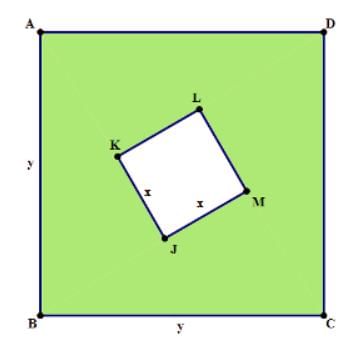
ABCD is a square with a side y, and JKLM is a square with side x. If Rectangle S (not shown) with length x + y has the same area as the shaded region above, what is the width of Rectangle S?
Consider a set S = {2, 4, 6, 8, x, y} with distinct elements. If x and y are both prime numbers and 0 < x < 40 and 0 < y < 40, which of the following MUST be true?
I. The maximum possible range of the set is greater than 33.
II. The median can never be an even number.
III. If y = 37, the average of the set will be greater than the median.
There are two sets of letters, and you are going to pick exactly one letter from each set.
Set #1 = {A, B, C, D, E}
Set #2 = {K, L, M, N, O, P}
What is the probability of picking a C and an M?
If x and y are integers and |x - y| = 12, what is the minimum possible value of xy?
If the ratio of the sum of the first 6 terms of a G.P. to the sum of the first 3 terms of the G.P. is 9, what is the common ratio of the G.P?
Each of the question below consists of a question and two statements numbered I and II are given below it You have to decide whether the data provided in the statements are sufficient to answer the question Read both the statement and answer the following question.
How is K related to N?
I. N is the brother of M who is the daughter of K
II. F is the husband of K
The number of people in the world who natively speak Language A is 330 million. The number of people in the world who natively speak Language B is 260 million. Language experts who chart the growth of both languages claim that in five years, the number of persons who natively speak Language A will be approximately 450 million, and the number of persons who natively speak Language B will be approximately 300 million.
In the table below, identify the average annual rate of growth of Language A native speakers, and then identify the difference between Language A’s and Language B’s average annual growth rates. Make only two selections, one in each column.
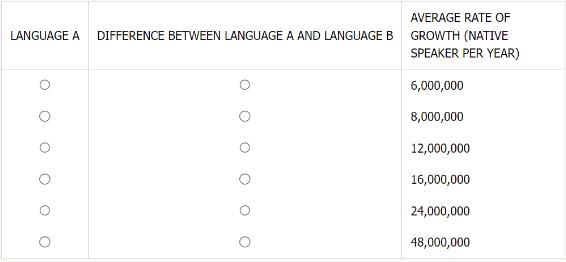
What is the standard deviation (SD) of the four numbers p, q, r, and s?
Statement 1: The sum of p, q, r, and s is 24.
Statement 2: The sum of the squares of p, q, r, and s is 224.
Window 1: Article about hardwood consumption
Currently the global economy consumes roughly 15 billion cubic feet of hardwood per year. This is nearly 2.5 times the amount of hardwood consumed annually in the 1950s. This causes a number of environmental issues, including loss of watersheds, destruction of habitats, increased air pollution, and landfill crowding.
Global hardwood consumption is expected to steadily increase, growing by roughly 20% in the 2010s and by more than 50% by 2050. The effects of the growth will be devastating to the world’s hardwood forest. It is estimated that currently 10 times more trees are lost annually to wood consumption than are replanted, resulting in a net destruction of 40 million forest acres annually.
Window 2: Analysis of hardwood industrial paths
All wood consumption flows through two industry paths: construction use and stationery consumption. Construction use wood begins at sawmills and becomes lumber, plywood, veneer, wood paneling, construction material, and furniture stock. Stationery wood goes to the paper mills and becomes paper, cardboard, and fiberboard.
Generally, 50% of all cut hardwood goes to sawmills for wholewood projects; 20% goes to chip mills for fuel consumption, particleboard creation, and other semiwood products; and the remaining 30% goes to pulp mills. Unfortunately, roughly 25% of the wood that is cut never actually reaches consumers, because wasteful manufacturing practices render it useless and send it straight to landfills.
Window 3: Article on tree use
The United States is the greatest global consumer of hardwood products, using more than 17% of the 15 billion cubic feet cut annually. This is roughly twice the consumption rate of other industrialized nations and three times that of developing countries.
The average American consumes 886 pounds of paper per year. This is twice that of most European residents and more than 200 times that of Chinese persons, who consume only 3 pounds of paper per year.
Q: Consider each of the items listed below. Select Yes if the item can be determined based on the information given in the three sources. Otherwise, select No.
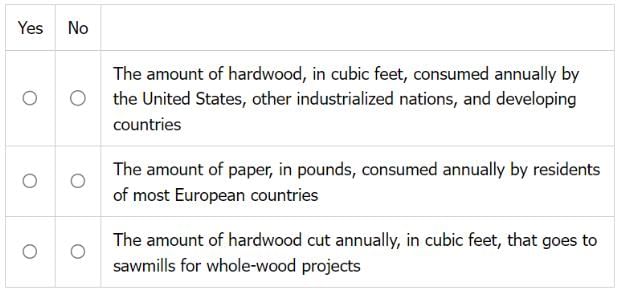
What is the value of X, if X and Y are two distinct integers and their product is 30?
Statement 1: X is an odd integer
Statement 2: X > Y



